
Cryptocurrency airdrops often feel like “free money falling from the sky,” but experienced airdrop players know that not every airdrop is worth the gas and effort.I have participated in dozens of airdrops over the past 5–7 years, some resulting in six-figure gains, and others worth nothing.
The difference lies in whether it can be carried outcareful assessment.In this report, I will try to propose a framework for evaluating the potential of airdrops.
I have developed an objective evaluation method to determine whether an airdrop opportunity is worth participating in.I will cite real cases (from Uniswap’s legendary airdrop to various recent L2) and quantitative benchmarks to provide reference for practitioners and help them identify high-potential, low-risk airdrop opportunities.
Key factors in evaluating airdrops
Assessing airdrop potential is not about guessing or following trends, but a structured process.Break it down into several key dimensions, each involving a key influence on return or risk:
-
Agreement Basis and Narrative
-
Token distribution and economic model
-
Eligibility Criteria and Sybil Attack Resistance
-
Input, Cost and Risk and Return
-
Market conditions and timing
-
Liquidity and Exit Strategies
Below we’ll dive into each of these, what questions are raised, and why they matter.
Base Agreement and Narrative
Before entering the testnet or transferring funds across the chain, you must first evaluate the quality of the project itself.Airdrop is not magic, its value ultimately comes fromThe success of the underlying protocol.
● What problem does the project solve?Is it a real demand or does it rely on hot spots?
A solid application scenario or real technological innovation (such as new scaling solutions, unique DeFi modules) means that the token may still maintain value after the initial popularity has passed.For example, Arbitrum was the leading L2 on Ethereum before issuing tokens, and had real users and ecosystem, which gave participants sufficient confidence in the value of its airdrop.On the contrary, even if many “copy projects” with no unique value are issued coins, their prices often stagnate after hunters sell them.
● Does the project fit into a strong narrative or market trend?
The crypto market is driven by narrative.In 2023–2024, topics such as modular blockchain, re-staking, and ZK-rollup attracted the attention of a large number of investors.Projects that fit a popular narrative (such as modular data networks like Celestia) tend to receive excess demand for their tokens when the narrative is strong.But the narrative reverses just as quickly.I personally prefer projects whose narratives are supported by technical hard power.
● Are users and developers really active?
Check on-chain data and community activity.High testnet participation, an active Discord, and weekly development updates are all positive signs.It would be better if user behavior is not purely speculative.For example, Blur (NFT trading market) has experienced explosive growth and real transaction volume during the airdrop gamification process, indicating that its growth is not just pure speculation, but has real appeal.
A decent basic narrative and active users are the cornerstones of airdrop value.If the protocol itself is not good, no matter how clever the airdrop mechanism is, it will not save the long-term value of the token.
I stepped on a trap in 2022: I spent several months on some L1 testnets, but these chains never attracted real users.Even after the coin was issued, there was almost no buying demand, and the price soon plummeted by more than 90%.
In short, if you have no interest in the project other than airdrops, then think again. Projects that rely solely on “airdrops for airdrops” will most likely not be able to provide long-term, redeemable value.
Token distribution and token economic model
Token design is the second critical part of assessing the value of an airdrop.These include airdrop distribution ratio, value capture mechanism, lock-up rules and valuation rationality.Here are the core metrics I focus on:
-
User allocation proportion
-
value capture mechanism
-
Unlocking and locking rules
-
Fully diluted valuation
-
Pre-IPO market structure
-
distributive fairness
1.User assignment
How much will the airdrop be distributed to users?
Allocating a sufficient proportion of airdrops to users can usually lead to stronger community stickiness and form positive support for prices.Judging from empirical data, users who allocate >10% of airdrops generally have better retention and performance, while those who allocate <5% of airdrops often experience the phenomenon of "second smash and rapid breakout".For example, Uniswap’s legendary airdrop in 2020, which allocated 15% of the $UNI supply to users, was worth approximately $6.4 billion at its peak, and successfully established a user community willing to govern.
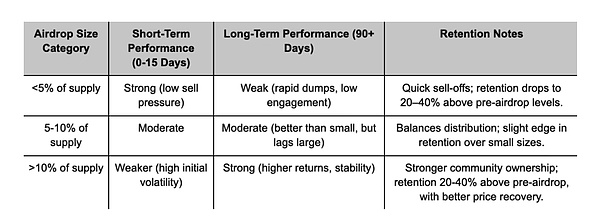
Instead, user allocations for multiple airdrops in 2024 are very small, with most of the tokens in the hands of insiders.A small number of user shares were quickly sold on the day they were listed, and the price never recovered.Celestia’s “Genesis Drop” allocated approximately 7.4% of $TIA to the test network and early participants; Arbitrum’s airdrop in March 2023 accounted for approximately 11.6%.Both of these ratios are enough for users to “truly participate” in the ecosystem instead of being marginalized.If the community only gets a small amount of supply, I would immediately flag it as a high selling risk.
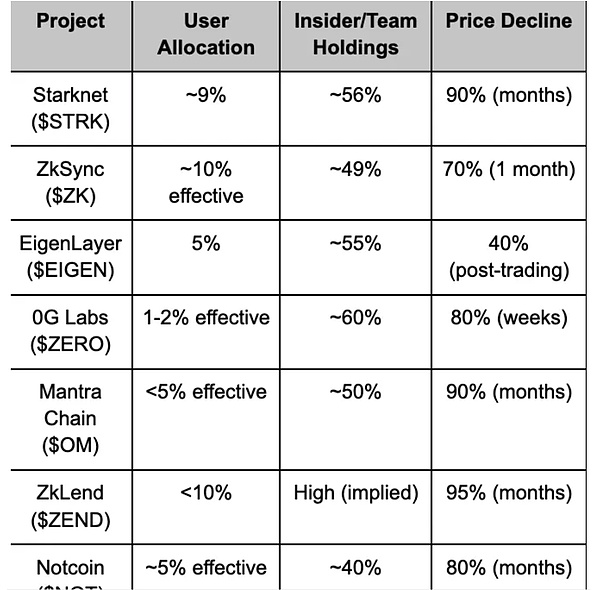
2024 Cryptocurrency Airdrop, Low User Allocation, Internal Dominance.
2.value capture
What is the purpose of tokens?Can value be derived from the success of the agreement?
Not every token can benefit from the success of the protocol, which is the source of the ultimate failure of many airdrops.
Some tokens are only used for governance (such as $UNI, $DYDX).Governance can constitute long-term value when a DAO truly controls cash flow or key parameters.But in low-fee or passive agreements, governance rights often become “cosmetic permissions” and the market quickly undervalues them.
Other income-linked “value tokens” (such as $HYPE, $GMX) bind real or synthetic income streams to the token through staking, buyback, dividends, or protocol native income.This model is more friendly to airdrop participants, as they can not only earn airdrops, but also choose to hold them for a long time to obtain cash flow.I prefer tokens that have real economic value, rather than just governance; it is best to actually capture the fees, inflation, or various benefits of the protocol.
3.Unlocking and locking
Can I trade immediately after receiving the airdrop?Is there any lockup?
For hunters, airdrops that are immediately liquidable are often better because profits can be locked in.If tokens are not transferable or locked up for long periods of time, you are essentially forced to become a “long-term investor.”A typical failure case is the $EIGEN airdrop launched by EigenLayer in 2024. Users have been collecting points for a whole year, but the token was not tradable when it was first launched, which caused widespread dissatisfaction among hunters because it could not be liquidated.
Generally speaking, I will avoid mechanisms that do not give users a choice, such as forced long-term lock-up or veToken-style complex lock-up designs, unless I have extremely high confidence in the long-term value of the project.My strategy is simple – I want to have optionality – I can hold it if I want to, but I can sell it immediately if I don’t.A principle worth remembering: “No protocol is 100% secure, so no airdrop warrants the assumption that I will always hold 100%.”
4.Fully diluted valuation FDV
Before the token is launched, its FDV is estimated (Total token amount × expected price after listing).
If FDV is too high, token prices are almost certain to come under pressure.To understand,Airdrops do not violate the most basic valuation logic, there is no magic that can make high valuations sustainable.In 2024, many airdrops were launched with extremely high FDV, only to quickly plummet within two weeks50–80%.
A study of 62 airdrops showed that88% of tokens drop within 15 days of listing, the root cause is often unreasonable initial pricing.
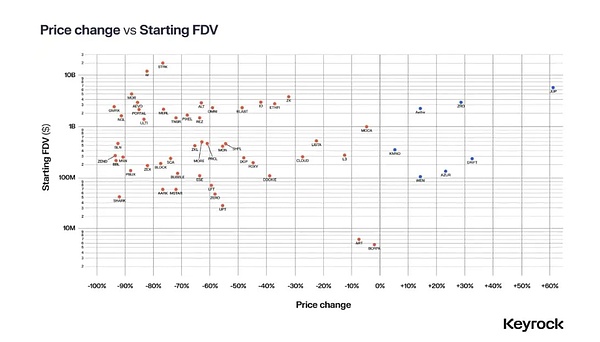
Performance of newly launched crypto tokens relative to their FDV
I will seek a certainmargin of safety,If the market value of similar projects is around $500 million, but the implied valuation of a certain project is as high as $5 billion, you must be wary.On the other hand, if a project is of high quality but has a relatively modest initial market capitalization, that is usually a positive sign.Also considerLiquidity,Will the token be listed on mainstream exchanges?Are DEX liquidity pools deep enough?If there is insufficient buying capacity, even excellent projects may experience severe selling pressure in the early stages.Among the few airdrops in 2024 that are able to maintain value beyond the first month, a common feature is thatReasonable FDV and deep liquidity.
5.Pre-TGE Market and Early Valuation Signals
A new trend worthy of attention is the rise of the Pre-TGE (pre-token generation event) market. Many projects related to airdrops will start trading through perpetual contract DEX or over-the-counter channels before the official issuance.
These early markets are often priced based on narratives, with the implied FDV often reaching billions, and more often than not, they are just based on emotions and expectations.For airdrop participants, such signals are critical.If the price of Pre-TGE is high, it usually means that the narrative is strong and market expectations are strong, which means that further participation may have greater return space; but at the same time, the risk is greater, because if the fundamentals do not really support the premium, the token may see price retracement soon after it is opened for redemption.In short, the Pre-TGE market is both a driving force and a risk amplifier. It can tell you the market’s true “appetite” for projects, and it may also be an early warning before the bubble bursts.
I view these early price signals assentiment indicator, rather than a value guarantee.The key is to recognize when a market has unrealized potentialPaid an exorbitant premium, and promptly adjust one’s exposure before this dislocation is corrected.
6.distributive fairness
One needs to examine whether airdrops may be too concentrated in the hands of a few wallets, or if they are more evenly distributed.
Highly concentrated airdrops mean that a small number of whales may be selling to drive down the price.For example, while Arbitrum’s airdrop was generally generous, some high-scoring users (top of the leaderboard) received the maximum $10,250 $ARB quota, forming a group of “instant whales.”
Interestingly, a small number of wallets tend to receive the majority of tokens.If I see signs in the data (e.g. Dune dashboard or project blog) that “the top 1% of participants will get the lion’s share”, I factor that into my risk considerations.I would prefer to set a cap on individual rewards or use a quadratic distribution formula design to avoid a winner-takes-all outcome.For example, Blast L2’s points program introduced activity-based caps so that even average users could receive meaningful quotas, thus preventing a “rich get richer” dynamic.
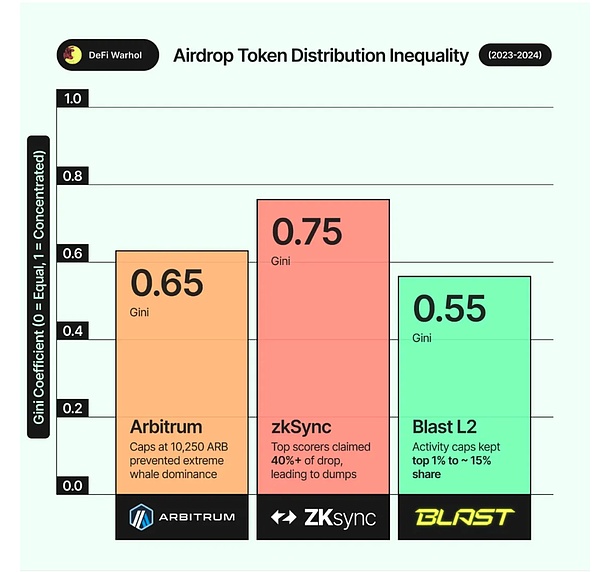
All in all,Higher community allocation ratio, sufficient liquidity of tokens and reasonable valuation, usually means airdrops are healthier and more worthy of participation.And thoseVery small share or high degree of lock-up and overvaluationAirdrops are often of the “snap and throw” type.If you can enter the market quickly, you may make some short-term profits, but usuallyNot worth investing a lot of upfront effort.
Eligibility Criteria Total Resistance with Witches
Next, let’s take a closer look at how to qualify for airdrops and the measures that projects may take to prevent Sybil attacks (multi-account airdropping).This helps determine the probability of actually getting the airdrop, and how the operation can be scaled (using multiple wallets vs. just one).
1.conditional transparency
How much disclosure does the team disclose about qualifications?
Some airdrops areRetroactive with surprise conditions(For example, the Uniswap airdrop, when anyone who used Uniswap could claim 400 $UNI); others areTask or points based, completed within a period of time (such as Optimism, Arbitrum, many testnet “tasks”).If the conditions are public (or at least can be inferred from documentation/leaks), list them and assess the difficulty.
For example, Arbitrum’s airdrop exposed the behavioral requirements for the points system (bridging funds, trading in different months, providing liquidity, etc.), which allowed me to plan ahead, inGet the highest points in your wallet.
On the other hand, if the conditions are vague, you may have to over-engage (try various operations) to ensure that all possibilities are covered, which will be inefficient.
2.Investment and return per wallet
Estimate how much a qualifying wallet might earn.
Sometimes teams will hint at different levels, or they can be extrapolated based on past airdrops.For example, many average user wallets of Ethereum L2 can eventually get tokens worth 500-2000 US dollars; if I judge that this airdrop may be in this range and the task is simple, it is a good deal.But if it requires extremely high investment (e.g. running a node for months) to get similar returns, I might just operate one wallet, or give up altogether.On the other hand, if it’s possible to make five-figure gains (like early dYdX traders got several $DYDX), then the high investment is worth it.
I would also consider whether using multiple wallets actually increases returns, or if the rules would limit multi-account operations.
Many airdrops explicitly targeted Sybil. For example, Optimism identified and eliminated more than 17,000 Sybil addresses in 2022 (accounting for approximately 6.8% of claimable wallets); Hop Protocol even recovered tokens from Sybil addresses after the airdrop.
If a project is explicitly anti-Sybil, using dozens of wallets may be counterproductive – wasting gas only to be disqualified.
My rule is, when Sybil risk is high, concentrate on one or a few high quality wallets (real active) rather than diversify your operations.
3.witch resistance mechanism
In addition to directly banning Sybil addresses, attention should also be paid to whether the point weight or condition design is biased towards real users.
Some projects will give higher rewards for behaviors that are difficult to forge, such as: long-term activity, on-chain reputation NFT or KYC certification.In 2024, LayerZero flagged 800,000 addresses as Sybil and planned to cut its rewards to 15% of normal.
Starknet’s first airdrop required at least 0.005 ETH to be held in L2 at the time of the snapshot, which may seem like a small requirement but still excludes many real users who did not reserve funds in L2.I will consider these types of special conditions and if I find unusual requirements (minimum balance, specific NFT, etc.) I will adjust the strategy, such as ensuring that all addresses meet the minimum balance before the snapshot.
In addition, if the project has testnet NFT or Crew3/Galxe activities, these may also be prerequisites for receiving airdrops; missing early tasks may result in being unable to receive them at all, so I will track this information closely.
4. Risk of rule changes
The worst thing that can happen is that you complete all the tasks only to be disqualified because of a rule change.Although rare, some projects adjust conditions at the last minute in response to Sybil attacks or modifications based on community feedback.There have been cases where some users who were thought to be eligible were eventually excluded, triggering community backlash.Staying active in the project community helps.I’ve also seen some protocols indicate what actions are considered violations (e.g. one address funding dozens of new wallets = banned).
I prefer projects with clear communication, but always assume the possibility of exclusion is not zero.This mindset prevents overconfidence.An important principle is, “If you miss an airdrop, it’s your fault, no excuses.” On-chain data doesn’t care about excuses, so I’ll do it in a way that looks natural under scrutiny.
In short, understanding the eligibility conditions and Sybil risks allows us to judge the intensity of competition for airdrops and how to arrange strategies.High Sybil risk scenarios require more caution (best to focus on one reliable identity); open-ended free grabs (no Sybil checks, purely quantitative tasks) can try multi-wallet strategies, but tend to be heavily diluted in return.It’s a delicate balance, and my default strategy is to play “real high active user” on at least one account, which usually gets past most Sybil filters and earns measurable rewards.
Investment, cost and risk vs. return
Airdrops are essentially investmentstimewithfundsAn investment behavior, so I must do a cost-benefit analysis at the beginning.
1. Time and complexity
Some airdrops are “one-time operations” (for example: making a trade on a certain DEX).Others, like testnet programs, may take weeks to run the software and complete tasks, or continue to be used over several months.I’ll break down the entire process.If the task list contains dozens of operations (such as cross-chain, exchange, providing liquidity in multiple dApps), I will estimate the total time investment.
Spend 100 hours in exchange for $500The reward rate of return is very poor,I would rather devote that time to projects with greater potential.I’m especially wary of “points events” that don’t have a clear end time.These activities often become an endless treadmill with diminishing returns.Some L2 incentive plans in 2022 taught me to set an “exit threshold”, for example, “If my points are less than X% of the top users after one month, re-evaluate whether to continue.”
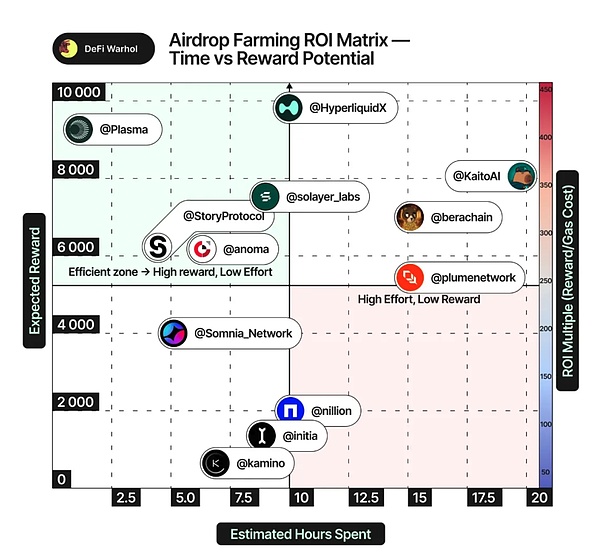
2. Gas fees and direct costs
I would calculate how much gas and other costs (cross-chain fees, minimum deposit requirements) might cost.For example, some of Arbitrum’s qualifications require more than $10,000 across the chain and ongoing operations over multiple months.In times of high gas these are not cheap.These costs must be compared with potential benefits.
A very practical approach is toFirst test the gas by running a few transactions, and then multiply it by the number of tasks or the number of wallets.I stopped farming many times because although the narrative was strong, the gas cost was much higher than the expected return.Especially during the high-rate period in 2021, many small airdrops are simply not worth paying $100 to “receive coins”.
3. Funding risk
Does it require you to lock in large amounts of assets or bear market risks?Providing liquidity, lending, and pledging may bring impermanent losses (IL) or smart contract risks.For example, during the DeFi “liquidity mining” craze (such as Sushi), although some mining brought additional airdrops, it also encountered risks such as IL and protocol attacks.
If a large amount of money had to be deposited into a new project (e.g. new bridge, new lending protocol) in order to qualify, I would check if there are audits, contract maturity, team credibility, hacker risk.Hacking is not a theoretical event. From the breach of Ronin’s $600 million cross-chain bridge to the failure of many smaller test bridges, I have seen many people lock their capital into a vulnerable system because of chasing airdrops – and ultimately suffered heavy losses.
4. Worst-case scenario assessment
One question I will always ask myself is: “What if I end up getting nothing?”
If the answer is “I’ll waste more time or money than I can mentally handle,” then it’s not worth participating in this time.I assume that a certain percentage of farms will fail (the project cancels the airdrop, I am filtered out, or the token is worthless).For example, I spent many hours on some L1 testnets (I won’t name them), but they never issued coins – pure sunk cost.These failures taught me to minimize irreversible losses.
In the time dimension, I will set up regular checkpoints to re-evaluate and not let myself be blinded by the “sunk cost fallacy”; in the money dimension, I avoid spending a lot of gas and remain flexible, such as automating operations with scripts or selecting periods when the network is not congested to reduce costs.
To determine “if it’s worth it,” I usually do a quick Expected ROI calculation: airdrop probability (assuming 80% will be issued, 20% will be cancelled) multiplied by the expected token value (e.g. ~$1000 per wallet) minus the cost.If the results are clearly positive and the qualitative factors are OK, I’ll participate.If the results are close to breakeven or negative, I give up or wait for more clear signals.
Market environment and timing
1. Bull Market vs Bear Market
In a bull market, airdrops can often bring extremely high returns.Tokens typically list at higher valuations and have stronger buyer FOMO sentiment.On the contrary, in a bear market, even if the project itself is good, the market demand for the token may be tepid when it is launched.For example, many large airdrops during 2022–2023 (such as Optimism, Aptos, etc.) occurred in a bear market environment, which also resulted in heavy selling pressure and slower price recovery in the early stages of launch.
As for the airdrops in the 2021 bull market cycle, many tokens continued to rise after being launched.I won’t deliberately try to perfectly time the macro market (the airdrop itself is actually relatively market neutral before the token is launched), but the market environment will affect my exit strategy (more on this later) and how actively I participate.In a strong bull market, I will participate in more opportunities and be more willing to hold some tokens for a longer period of time; in a deep bear market, I will only select projects with the most potential and tend to sell them as soon as they are launched.
2. Narrative cycle
I mentioned narrative and fundamentals before, but here the focus is more on timing. Is the current narrative on the upswing, or is it already crowded?
For example, the restaking narrative in early 2024 is very popular, and as long as there is a little anticipation of airdrops, there will be a lot of attention.If you participate early (when TVL is still low), your behavior is more conspicuous; but by 2024 Q1, later participants are already crowded into a very crowded pool.
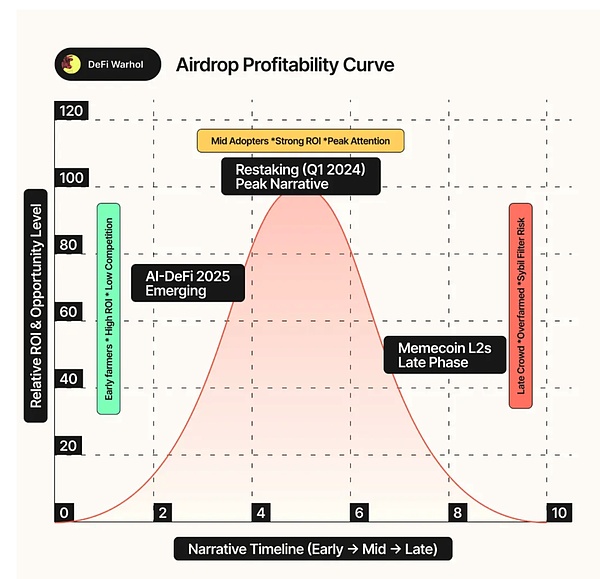
I will judge whether the “meta-narrative” of an airdrop route is early or late. If everyone on Crypto Twitter is talking about a certain testnet, it usually means that the easy money has been mined; Sybil attack scrutiny will be stricter.And a relatively quiet activity in the new narrative may be a treasure.For example, in 2025, hybrid AI + DeFi protocols begin to gain attention; airdrops in this segment may be less crowded and have a higher success rate.
3. The rhythm of the project itself
Consider where the project is on the roadmap, if mainnet or token issuance is imminent (within weeks), you don’t have much time, and the standards may already be largely set.
If it is a long-running test network with no announced end time, you have to judge how long it will take.Some programs have a “season system” and it would be helpful if the schedule was made public.Pay attention to the snapshot time. Many airdrops take a snapshot of user behavior at a certain block height.If you know or feel like a snapshot is coming, that’s the time to finally check in on the adequacy of your actions (or spend less if you feel you’ve done enough).
4. Reactions to news and setbacks
This one is more subtle, but critical: observe how the project reacts when it encounters bad news or unexpected situations.For example, after the test network goes down, will users return?Has the team postponed the Token Sale?Is the team professional and transparent when encountering security incidents or hacker attacks?
If the project can properly handle the crisis and community users are still willing to stay, it means that the project can survive the storm, which will actually strengthen my confidence.For example, despite disputes and FUD over airdrop distribution and governance, the number of users of Arbitrum and Optimism continues to grow, indicating that the underlying demand is real.On the other hand, if a small delay sends the community into a rage, that means the interest is too superficial.
In short, the market background is very important. During the period of overheated emotions, everyone is farming and the competition is fierce, so I will be more cautious; during the low period (no one is willing to invest time), it may be the time when the airdrop returns are the highest.For example, my biggest airdrop profit came from the period when everyone was “disheartened” at the end of 2022; when those projects were launched in 2023 (such as Arbitrum), I was one of the few who insisted on farming, so I captured the huge popularity of the listing.
Liquidity and Exit Strategies
Finally, I will plan how to realize the value of the airdrop once it is received.The old trading adage goes: “Plan your trade first, then execute your plan.” For airdrops, this means:
1. Collection strategy
Once tokens become available for redemption, the price may fluctuate dramatically.I remember the Arbitrum collection day. On that day, users paid extremely high gas, RPC crashed, and the scene was chaotic.
I will prepare in advance to set up a backup RPC, script the claim (if possible), and race against the clock when the market opens.If there are multiple wallets, I usually prioritize those I intend to sell immediately to get ahead of the rush, while smaller wallets can be claimed later if they are intended to be held for the long term.
Also, check to see if there is a collection deadline.Many airdrops allow for claiming for several months, but some may recycle unclaimed tokens to the DAO after a certain period of time.(For me, missed pickups are usually not a problem and I get them as soon as possible.)
2. Market Liquidity
I prefer airdrops that can be traded on well-known exchanges or have sufficient liquidity on AMMs as soon as they go online.If the project has major investors or interest, it’s likely that Binance, Coinbase, etc. will list it directly, or at least have large DEX pools provide liquidity upfront.For example, Arbitrum’s $ARB traded almost instantly on major exchanges, with daily trading volume exceeding $1 billion, making exiting relatively easy.In contrast, niche airdrops may only trade on a single DEX and be illiquid, and large sales may cause prices to plummet, or slippage to eat into profits.
I would research ahead of time and if the team announces market maker collaboration or exchange support, that’s a green flag.On the contrary, if it was a niche Cosmos airdrop that required exchanging tokens in the native wallet, I would expect larger price fluctuations and adjust my position accordingly (or simply give up if necessary).
3. Sell, hold or pledge
I will decide in advance how much to sell and how much to hold after receiving the tokens.Experience shows that most airdrop tokens usually peak within the first two weeks.
My tendency is to sell a portion as early as possible. A typical strategy is to take about 50% of the day’s sale, lock in the profit, and hold the rest with a trailing stop or target price.
This protects against common sell-off risks while preserving upside potential.Only in special circumstances (high confidence in the project, or initial price significantly lower than fundamental valuation) would I hold a majority of tokens.Even if I hold, I will typically stake or lend the tokens to earn additional yield, but do so with caution: if staking requires a lock (such as a governance lock), I weigh the loss of flexibility.
4.Tax and legal considerations
I cannot completely ignore compliance and regulatory issues.Airdrops are generally considered taxable income in many jurisdictions (at least taxed on the value as received).Large airdrops may come with tax liabilities, so I will set aside funds to pay taxes.
Sometimes selling immediately is also more secure in paying taxes.Also, pay attention to geographical restrictions.For example, EigenLayer once banned American users from receiving airdrops.I would keep an eye out for projects requiring KYC or geo-blocking.If so, this airdrop may be basically ineffective for me, or I may need to participate through a more friendly judicial entity.This is an emerging issue, as some 2025 airdrops, for example, have begun requiring simple KYC to comply with regulatory requirements.
Essentially, airdrops are not considered profits until they are liquidated.I have an exit plan for every airdrop to avoid being trapped in a rapidly devaluing token.
Best Practices and Final Thoughts
With all that said, here are the best principles I follow when evaluating whether an early airdrop is worth the investment of time.
1.Do your homework
Before rushing into any “new project” be sure to research the project’s fundamentals and token plans.If possible, read project documentation or governance forums for clues about token issuance.Many missed opportunities come fromWrong assumption that there will be an airdrop(or vice versa).Don’t just rely on hearsay; verify what is realistic and possible.
2.Establish a hypothesis first and then continually verify it
Make it clear why you think this airdrop may be valuable, for example: “This project is leading in the new track and may issue tokens with a lower initial market value and obtain strong demand.” Then use on-chain data and news to continuously verify your assumptions.If the narrative breaks (such as growth stagnating, competitors overtaking), adjust or give up in a timely manner.Flexibility is a strength; stubbornly clinging to a false assumption will only waste months.According to my experience,Self-esteem and confirmation biasis the biggest enemy.Never think you “deserve” an airdrop; adjust your strategy as reality changes.
3.Quantitative scoring and comparison
Each opportunity can be scored along multiple dimensions (fundamentals, token economic model, input costs, etc.).I sometimes configure weights using tables, for example.Agreement quality 30%, return potential 30%, cost/risk 20%, witch difficulty 20%.This quantitative approach forces you to address your project’s weaknesses.A project may be very popular, but if the token distribution is poor, the overall score will still be lowered.After rating, you may find,A less popular airdrop has a better risk-reward ratio, more efficient than a popular project with 100,000 people competing.
4.Manage risk, not gamble
Think of airdrops as an investment portfolio.Spread your strategy among several promising opportunities rather than going all-in.This way even if one fails (no airdrop or low price), other projects can make up for it.I typically run 5–10 projects in parallel in a quarter, with the expectation that only half of them will actually generate revenue.Always remember capital preservation.“Be there when the giant airdrop comes.”This means don’t burn all your ETH on gas for fringe projects.Save your ammunition so you can rush in when the real “big opportunity” presents itself.
Pay close attention to on-chain signalsPay attention to the project wallet growth, testnet usage, and scoreboard (if public).
If you find that your relative position continues to decline during the inspection process (others have done more than you), you need to re-evaluate whether it is worth continuing to invest.Likewise, if project activity declines, that also means community interest is fading, which is usually a bad sign for the future value of the token.
5.Plan your exit (and entry) strategy
From the moment you enter, you need to think about your ultimate exit.Figure out how to claim it, how to sell it, and try to avoid thin liquidity situations.If there are signs that there will be long lock-ups, or that trading can only be done on a single-chain DEX, you need to judge whether it is acceptable.If you can’t, you probably shouldn’t be involved in the first place because you won’t be able to exit smoothly in the end.When the airdrop is actually distributed, don’t be controlled by greed or fear and exit as planned.I have seen people get an airdrop of 10,000 US dollars and wanted to wait until 20,000 before selling, but the result dropped to 2,000. Don’t be that person.Systematically realize profits.It’s not every day that someone sends you tokens for free, so there’s no shame in locking in earnings.
6.Keep learning and iterating
Every airdrop, successful or unsuccessful, contains lessons.Write it down or at least review it in your head: Was a project overestimated?Missed a key qualification?Or a slighted project that later exploded (that “I should have done more if I had known better” pain)?Use it to optimize your framework.Over the years, my attitude toward airdrops has become more “skeptical but opportunistic,” remaining skeptical of hype but decisive when I see mispriced opportunities.The goal is to develop an intuition,Identify scenarios where the market underestimates the value of airdrops and you can profit from them.
Summary
Evaluating early airdrops is part art and part science.You need to understand human nature, the art of incentives and narrative, and the science of analyzing data and token economics.The best airdrops tend to reward early, authentic participation rather than one-time interactions.This means that really early adoption and support of great projects will often yield the greatest returns.
My framework helps me filter out these opportunities.By paying attention to fundamentals, being realistic about token design, carefully evaluating investment versus reward, and staying adaptable to new information, I can significantly increase my odds of only participating in airdrops that are truly worthwhile.
Ultimately, airdrop hunting should be treated like any other investment,Do due diligence, manage risks, and formulate clear strategies.By doing this, you can find the signal among the noise and successfully seize the next opportunity at the UNI or ARB level when it comes.








